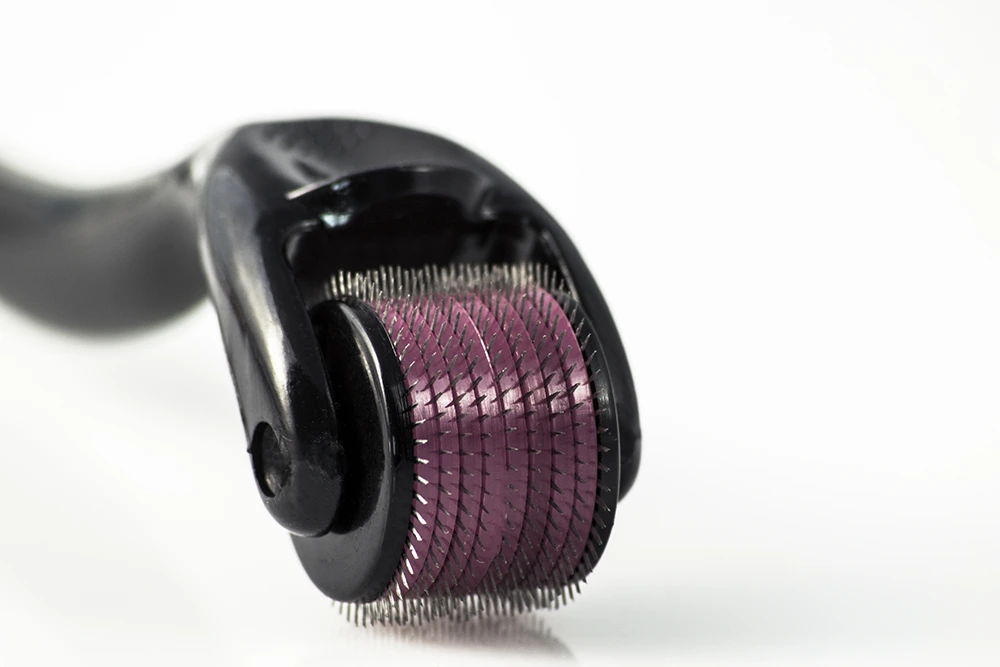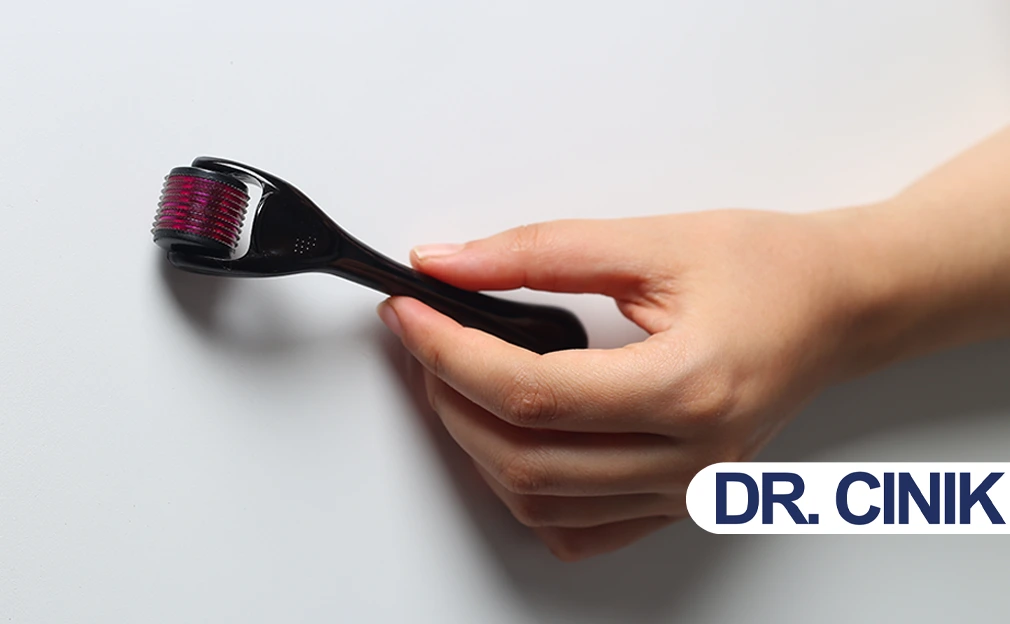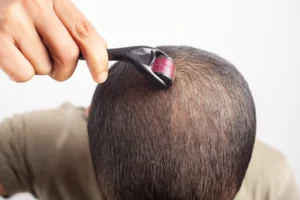Hair loss can feel extremely frustrating. Whether you’re noticing a few extra hairs on your pillow or struggling with thinning spots, you’re not alone. Millions of men and women (85% and 33% respectively) have faced the problem of hair loss at least once during their lives. While there are many treatments out there, using a dermaroller for hair loss is a method that’s been gaining a lot of attention.
Originally used in skincare for reducing acne, scars and wrinkles, dermarollers have found a new purpose: stimulating hair growth.
What is a Dermaroller?
A dermaroller is a small handheld device that looks a bit like a tiny paint roller — but instead of a sponge, it’s covered in hundreds of very fine, short needles. Yes, needles! But don’t let that scare you. The punctures from these needles are extremely small: you can only see them if you look very closely.
The process of this piercing is called microneedling. It’s actually quite simple and minimally painful when done correctly.

How Does a Dermaroller Help You with Hair Loss?
When you roll this device, its thin needles pierce your skin, leaving micro-injuries. Sounds scary? Don’t be afraid, it’s actually good for you. These tiny wounds trigger a natural healing process deeply in your skin. As your scalp heals, it releases growth factors and increases blood flow to the area, which can help stimulate hair follicles — the tiny structures in your skin that grow hair.
In short: a dermaroller wakes up sleepy hair follicles and creates the perfect environment for new hair to grow.
Pros and Cons of Dermarolling for Hair Loss
Pros of dermarolling
- Affordable and easy to use at home
- Drug-free and non-invasive
- Enhances absorption of other treatments
- Improves blood flow and scalp health
- Encourages natural hair regrowth
Cons of dermarolling
- Results take time (3–6 months)
- Improper use may cause irritation or infection
- Won’t be effective for certain types of hair loss (e.g., scarring alopecia)
- May not replace more intensive treatments like transplants
What Does Science Say?
Microneedling can also help other hair growth treatments, like minoxidil (commonly sold under the brand name Rogaine), work better. The tiny channels made by the dermaroller allow topical medications to reach deeper layers of the skin to maximize effectiveness.
In a study published in the International Journal of Trichology, people who used a dermaroller along with minoxidil grew more hair compared to those who only used minoxidil. Participants who combined both treatments saw thicker, denser hair after a few months.
Another research study published in the Journal of the European Academy of Dermatology and Venerology, also highlights microneedling’s great potential to enhance the absorption and efficacy of topical therapies.
However, it’s no secret that when it comes to treatments, results vary from person to person. Some people see major improvements, while others notice only a little change. Like most hair loss treatments, microneedling isn’t a panacea, but it can be a helpful part of a larger plan.
What Results Can You Expect?
Microneedling for hair loss is not a quick fix. Most users report noticeable results after 3–6 months of regular use. Common improvements include:
- Reduced shedding
- Increased hair density
- Thicker, stronger strands
- Visible baby hair regrowth
Full results may take up to a year, especially if dermaroller is used alongside other treatments like minoxidil, PRP (platelet-rich plasma) injections, or supplements.
How to Choose the Right Dermaroller
When it comes to microneedling for hair loss, needle size matters a lot. The length of the needles on your dermaroller determines how deep the device will penetrate your scalp — and how effectively it can stimulate hair follicles.
Most likely, your doctor will advise you to use a roller with needles from 0.5 to 1.5 mm long, although sometimes the shortest ones (as little as 0.25 mm long) will do. In a nutshell, shorter needles are gentler and better for beginners, while longer ones go deeper but can be more uncomfortable.
So, let’s take a look at a breakdown of commonly used needle sizes.
0.25 mm needles
These needles are very shallow. Most often, they’re used for boosting absorption of hair serums, like minoxidil. Good news is that they can be used several times a week. Bad news is that these needles don’t go deep enough to stimulate new hair growth, if used on their own.
0.5 mm needles
One of the most popular choices for home use. They reach a little deeper into the skin, so can noticeably increase blood circulation and mildly stimulate hair follicles.
These needles are great for beginners and are safe to use 2 or even 3 times per week.
1 mm needles
These ones penetrate deeper into the scalp, which encourages a stronger healing response. They are a good choice for people with noticeable thinning. But please note that you should use them just once per week to give your skin time to recover.
1.5 mm and longer
If you choose these needles, remember that very deep penetration can be uncomfortable or even painful. Using dermarollers with these needles requires certain skills. That’s why, if you have little experience, you’d better leave them to professionals in a clinical setting. Longer needles pose higher risk of irritation or injury, if used incorrectly at home.
What else should you look for in a good dermaroller?
Needle Material: Look for stainless steel or titanium needles. Titanium is stronger and lasts longer, while stainless steel is more affordable and sharper (but wears out faster).
Number of Needles: A roller with 540 needles is common and works well. More needles mean more coverage, but fewer needles can reduce discomfort.
Comfortable Handle: Make sure the handle is easy to grip — you’ll be using it regularly, so it should feel good in your hand.
From a Trusted Seller: Always buy from a reputable brand or shop. Cheap knockoffs may use poor-quality materials that can damage your scalp.
One More Important Tip for Dermaroller Users
Replace it regularly!
When you use your dermaroller time after time, its needles tend to go dull. That’s why experts recommend changing a dermaroller every 10–15 uses.
But there is a case when you must replace it immediately: if you drop its head on the ground. Don’t use damaged needles – it’s unsafe.
How to Use a Dermaroller for Hair Loss
If you’re interested in trying a dermaroller, it’s important to use it the right way. Here’s a basic guide:
Clean Everything
Perhaps it’s a needless reminder, but all the same: disinfect the device before and after each use. Washing your scalp before the procedure is also a must.
Roll the Right Way
Mentally divide your scalp into zones (front, sides, crown) for even treatment. Roll back and forth in vertical, horizontal, and diagonal directions about 4–5 times per section. Don’t press too hard when you move the device across your scalp; the needles only need to go lightly into the skin.
Don’t Overdo It
Limit time of a dermarolling session to 2 minutes. Besides, if you do microneedling too often, it can irritate your skin. That’s why, at first, just once a week is enough. Your skin takes it well? Add one more microneedling procedure a week; later, you can make it three times. Apply changes gradually.
Be careful with longer needles
If you use needles of 1 mm or longer, one time a week will do.
Let Your Scalp Heal
Don’t wash your hair for at least 12 hours after the procedure. Furthermore, avoid direct sunlight and sweat.
Be Patient
Don’t expect a quick effect: hair grows slowly. It means that you may have to wait 3 to 6 months for a noticeable result. Keep it up and be consistent.
Are there any side effects to microneedling?
For most people, microneedling is safe when done properly. However, you might experience:
- Redness
- Mild swelling
- Tenderness
- A little bleeding (especially if needles are longer)
These symptoms will in most cases fade away within a day or two. If you have sensitive skin or any scalp conditions (such as psoriasis or eczema), see your doctor before using the dermaroller.
Also, never use a dermaroller on infected skin or active acne on your scalp.
What About Professional Microneedling Treatments?
While many people use at-home dermarollers successfully, some choose to have professional microneedling treatments done at a dermatologist’s office. Professionals use more advanced tools, such as automated microneedling pens, which can deliver more consistent and deeper punctures with minimal discomfort. Besides, they customize the treatment to your needs. If you’re unsure about doing it yourself, or if you want faster results, seeing a professional might be a better choice. Professional microneedling combines microneedling itself with Platelet-Rich Plasma (PRP), peptides, or mesotherapy, which boosts hair growth.
And still, many people see success with just a dermaroller, especially in the early stages of hair loss.
Dermaroller, Dermastamp and Dermapen: Which is Best for You?
All three are tools to perform microneedling for hair loss. What are the differences among them and which device you should choose for the best results?
Dermaroller:
Rolls across the skin. Best for treating larger areas, like the whole scalp. Can cause some dragging if used too forcefully.
Dermastamp:
Presses needles straight into the skin. Offers better precision and less skin trauma. Good for spot treatments or delicate areas.
Dermapen:
An electric device with adjustable needle depth. Used by professionals for consistent and deeper penetration. Offers more control and better outcomes in clinical settings.
What does it mean for you? In a nutshell,
- Haven’t tried microneedling before? Start with a dermaroller with shorted needles.
- Have sensitive skin or are specific targeting small areas or spots like acne scars? Try a dermastamp.
- Need advanced treatment? Consider a dermapen under expert supervision.
Professionals often switch between tools, depending on the client’s needs — e.g., use a dermastamp for temples or patches, and a dermaroller for larger areas.
What Are the Alternatives to Dermarolling?
Microneedling itself isn’t the only way to treat hair loss. Here are a few other popular options:
- Minoxidil (Rogaine): This over-the-counter topical treatment helps improve blood circulation to the hair follicles, potentially encouraging hair growth and slowing down hair loss.
- Finasteride (Propecia): A medication typically prescribed to men. It works by lowering levels of DHT — a hormone linked to hair follicle[vc_row equal_height="yes" pix_particles_check=""][vc_column width="1/4" content_align="text-center"][pix_team_member_circle name_bold="font-weight-bold" name_color="heading-default" name_size="h5" bold="" title_color="secondary" outer_border="1" color="primary-light" items="%5B%7B%22icon%22%3A%22pixicon-facebook3%22%2C%22item_link%22%3A%22https%3A%2F%2Ffacebook.com%2Fdremrahcinik%22%2C%22target%22%3A%22true%22%2C%22has_color%22%3A%22true%22%2C%22item_color%22%3A%22secondary%22%2C%22item_custom_color%22%3A%22%23333333%22%7D%2C%7B%22icon%22%3A%22pixicon-instagram2%22%2C%22item_link%22%3A%22https%3A%2F%2Finstagram.com%2Fdr.emrahcinik%22%2C%22target%22%3A%22true%22%2C%22has_color%22%3A%22true%22%2C%22item_color%22%3A%22primary%22%2C%22item_custom_color%22%3A%22%23333333%22%7D%2C%7B%22icon%22%3A%22pixicon-youtube3%22%2C%22item_link%22%3A%22https%3A%2F%2Fyoutube.com%2FDrEmrahCinik%22%2C%22target%22%3A%22true%22%2C%22has_color%22%3A%22true%22%2C%22item_color%22%3A%22red%22%2C%22item_custom_color%22%3A%22%23333333%22%7D%5D" name="DR. Emrah CINIK" title="Medical Doctor" image="52"][alertblock secondary_font="secondary-font"... shrinkage and male pattern baldness.
- PRP Therapy: This treatment uses a patient’s own blood, which is processed to extract platelet-rich plasma. The plasma is then injected into the scalp to stimulate hair follicles and promote regrowth.
- Low-Level Laser Therapy (LLLT): This non-invasive method uses red light devices, such as helmets or combs, to energize hair follicles and support growth.
- Hair TransplantHair transplantation is a surgical procedure that involves the extraction of hair follicles from a designated donor site, followed by... Surgery: A long-term solution for advanced or irreversible hair loss. This procedure involves relocating healthy hair follicles from one part of the scalp to thinning or bald areas. Performed by specialists in Dr. Cinik’s center.
- Biotin and Hair Supplements: While not a cure, they can support overall scalp and hair health.
Expert Insight from Dr. Emrah Cinik
“Microneedling is among the most promising non-surgical methods of promoting hair growth. We’ve seen excellent results when combining it with other therapies like PRP or topical minoxidil.”
— Dr. Emrah Cinik, Hair Transplant Expert
Dr. Cinik’s center has helped thousands of people regain their hair using a range of cutting-edge technologies.
Final Thoughts
All in all, a dermaroller can be a helpful, affordable tool for boosting hair growth and treating hair loss. It’s not a miracle cure, but when used correctly — especially alongside other treatments — it can make a real difference.
Experts agree that using a microneedling for hair loss is a simple and cost-effective way to stimulate hair regrowth naturally. With consistent use and the right technique, it can help reduce thinning, improve scalp health, and enhance the effectiveness of other hair treatments.
While it may not replace clinical procedures for everyone, microneedling is a promising first step for anyone noticing the early signs of hair loss. As Dr. Cinik notes, combining microneedling with expert guidance and proper care offers the best shot at restoring your hair — and your confidence.
FAQ About Microneedling for Hair Loss
Q: Is microneedling painful?
A: It’s usually painless with 0.25–0.5 mm rollers. Slight discomfort or redness is normal, especially with deeper needles.
Q: I noticed some extra shedding after I started microneedling for hair loss. Should I worry?
A: Not necessarily. Light shedding can be part of the renewal process and often signals that new growth is on the way.
Q: Should I use minoxidil before or after microneedling?
A: If you combine microneedling with minoxidil, apply it 12–24 hours after using the dermaroller. Some apply medicine before rolling, but this can cause stinging and irritation.
Q: My hair started shedding and thinning after pregnancy. My doctor says it’s hormonal hair loss. Can I use a dermaroller for it?
A: Absolutely. Many women benefit from microneedling, especially for hormonal thinning or postpartum shedding.
Q: I have sensitive skin. Is dermarolling safe for me?
A: If you have conditions like eczema, psoriasis, or scalp infections, consult a dermatologist first.
Q: Can I combine microneedling with PRP or finasteride?
A: Absolutely. Many users combine treatments for better results, especially under a doctor’s care.
Q: Can I let my friend use my dermaroller?
A: No! Dermarollers are personal-use tools. Sharing this device may lead to infections.
Q: Six months have passed since I started using a dermaroller, but I see no improvement. Does it mean microneedling doesn’t work for me altogether?
A: No. Everyone responds differently to microneedling. Besides, you might benefit from adding another treatment, such as PRP or LLLT. Consult a dermatologist or trichologist (a hair specialist).

